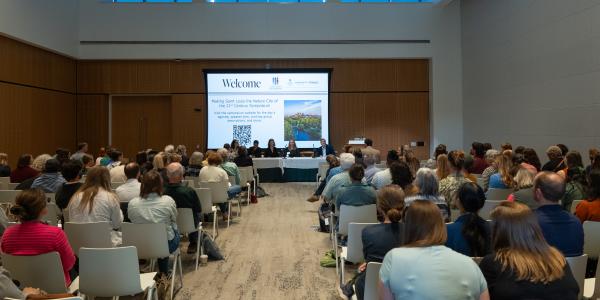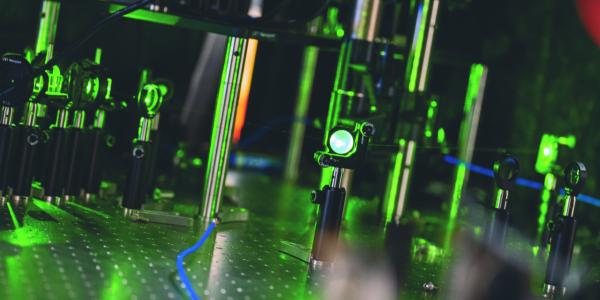Through transdisciplinary collaboration, the organization’s three working groups are redefining the region’s relationship with nature.
Nearly 300 St. Louisans working in conservation and biodiversity gathered for the Living Earth Collaborative’s second annual Making St. Louis the Nature City of the 21st Century Symposium. The event brought together researchers, educators, government officials, nonprofit leaders, and volunteers from dozens of organizations — all united by a shared goal of building a greener, more sustainable region.
That broad mix of perspectives also underscored one of the LEC’s challenges: how to align such a wide-ranging coalition toward a common vision for St. Louis’s natural ecosystems.

The LEC is addressing that question through its three working groups, whose members reconvened in person at September’s Nature City Symposium. Each working group has a different topical focus: urban biodiversity and access to nature, urban heat and trees, and water. Featuring multidisciplinary membership, the working groups look to bridge the gaps between research, policy, and implementation in the field.
Rachel Penczykowski, an associate professor of biology, serves as one of the co-leads of the urban heat and trees group. Its members include representatives from multiple local universities, the city of St. Louis, nonprofit conservation groups, and more. As the group studies how trees and other urban greening efforts can mitigate heat island effects, Penczykowski believes that the journey to those answers is just as valuable as the destination.
“The most important thing about our group is the different domains that we represent,” Penczykowski said. “We have an exciting opportunity to develop a framework for communication and information exchange between researchers and practitioners. For example, there can be a disconnect between practitioners’ needs for timely and straightforward answers and the typical timeline of conducting and publishing scientific research, which is necessarily a rigorous, long, and multiple-peer-reviewed process. We researchers also tend to be very cautious about how we interpret our work back to real-world applications. So, one of our group’s challenges is to figure out how to translate the practical needs of planners, policymakers, and folks who are on the ground planting and managing trees into questions that the scientists in the group can answer within a useful timeframe. The framework for communication and collaboration that we develop will be a valuable outcome in its own right.”
The process of working group members learning to speak the same language mirrors the evolution of the Living Earth Collaborative itself. LEC launched in 2018 as a partnership between WashU, the Missouri Botanical Garden, and the Saint Louis Zoo. But it found new momentum in 2023 after a comprehensive strategic visioning process, during which the three partner institutions refined their collaboration.
Last year’s inaugural Nature City Symposium served as a chance for the LEC to reintroduce itself to the community and build new coalitions. This year’s edition expanded the scope of those efforts.

Keynote speaker Doug Tallamy, the co-founder of Homegrown National Park, emphasized the role that everyday people can play in bolstering biodiversity through native plantings in their own backyards. A panel of experts discussed how the tornado that struck St. Louis in May impacted local ecosystems. The LEC’s working groups reported on their progress since forming at last year’s symposium and looked to recruit new members.
“Please don’t think these are just the Living Earth Collaborative working groups,” said Glenda Abney, vice president of sustainability at the Missouri Botanical Garden, after presenting on behalf of the urban biodiversity group. “These are working groups for the entire St. Louis region to advance efforts in these three topical areas. They happen because of a truly collaborative effort.”
Penczykowski said that collaboration extends across the three groups.
“It’s not like urban heat is disconnected from urban water, which is disconnected from urban biodiversity,” Penczykowski said. “These things are intimately connected in complex ways. There’s great value in having the Living Earth Collaborative as a consortium that’s supporting and facilitating dialogue and collaboration both within and between these different working groups. Our focal topics are all connected, and so are we.”





